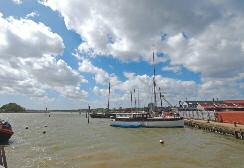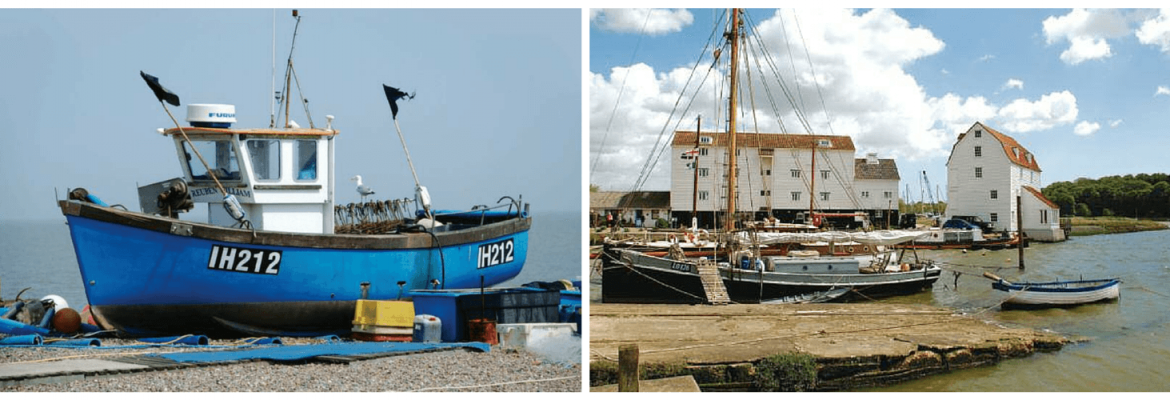Woodbridge
Woodbridge lies along the River Deben at the end of long estuary, about seven miles from Ipswich. With 1400 years of recorded history, the town has retained a wide variety of historical architecture, and there are facilities for boating and riverside walks on the River Deben.

Although the area was under Roman occupation for 300 years, very little evidence remains, as by the time the legions were recalled to Rome in AD 410 there was already a substantial Anglo-Saxon (Germanic) settlement there.
The town has been a centre for boatbuilding, rope-making and sail-making since the Middle Ages. Edward III and Sir Francis Drake had fighting ships built in Woodbridge. The town suffered badly in the plague of 1349, but recovered enough to have a new church (St Mary’s, situated behind the buildings on the south side of Market Hill)) constructed with limestone from the Wash and decorated with Thetford flint. After significant and persistent religious upheaval, the religious settlement under Elizabeth I helped Woodbridge industries such as weaving, sailcloth manufacture, rope making and salt making to prosper, alongside the wool trade. The port was enlarged, and shipbuilding and the timber trade became so lucrative that a customs house was established in 1589.
Around the town today there are various buildings from the Tudor, Georgian, Regency and Victorian eras. Woodbridge also has a tide mill in working order, one of only two in the UK and among the earliest. Two windmills also survive, Buttrum’s Mill and Tricker’s Mill, the former being open to the public.
Sutton Hoo
Just across the River Deben from Woodbridge lie the burial mounds of Sutton Hoo. Excavations in the months leading up to the outbreak of the Second World War revealed an amazing hoard of treasure held within a wooden Anglo-Saxon burial ship undisturbed for 1300 years.
Instantly becoming the most important Anglo-Saxon site in the UK, Sutton Hoo is thought to be the final resting place of the early seventh century King Raedwald of East Anglia. Raedwald was ‘Bretwalda’, the most powerful king in England, who died around AD 624. The 89ft burial ship and its many treasures, the iconic warrior helmet being one of the most important, were the richest ever found in British soil. They are now kept in the British Museum. Impressive replicas of some of the items, and the story of the finds, are to be found in the Woodbridge Museum. The National Trust has built an equally impressive new visitor centre on the site at Sutton Hoo including re-creations of the historical significance of the find.
Suffolk Punch Heavy Horse Museum
Housed in the fine Grade 1 listed Shire Hall at Woodbridge, this museum contains a fascinating collection of historic photographs, harnesses, mementos, paintings and silverware associated with this noble animal. There’s a harness maker’s shop, a large collection of horse brasses and the faithfully restored office of Herman Biddell, the society’s first secretary, containing a studbook tracing the pedigree of the breed.

